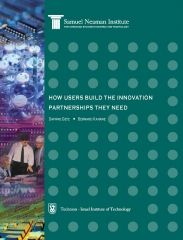Innovation is unlikely to be successful if it is founded on the supposition that the innovative process is essentially simple, linear and sequential. It is not. The innovative process is complex, intricate and irregular and basically it can be considered as a learning and information process. Successful innovation is the product of a total information package to which R&D makes only a partial contribution. There are additional contributions from other participants in the process, including the users of the new technology, whose input is just as vital as the information derived from R&D.
Thus, initial and continuous users’ implication in the innovative process is a key factor, which points to the potential of partnerships involving not only R&D producers’ (academic and industry) components but users as well. Nevertheless, although even if such a goal is looked for, successful incorporation of users in the innovation process is a difficult task since their identity, their legitimate representatives and ways of interaction with them are not necessarily obvious.
To help answer this issue, we here report through two very different case studies, forms of strategic partnerships for innovation, which not only incorporate innovation users, but also are initiated and shaped by them. These contrasted situations (one in Israel, the other in France; one outside of any government support, the other inside such a scheme) show how users find their way to shape new kind of alliances in order to achieve innovation. They stress the interactive nature of the innovation process and the interest of moving government intervention beyond academy industry relation, in order to incorporate innovation users.












